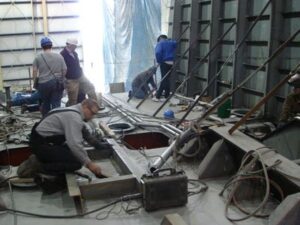

Engine room is full of machinery and pipelines that are made of different metals and alloys. Before repair and fabrication is done, it is imperative that the metal be identified so that successful repair is possible.
The first rule when selecting welding electrodes is that it must be equal or superior to the parent metal. (Read the Guide to Welding Electrodes on ships) Some metal are easily identifiable by color and weight, but some like ferrous alloys are very difficult to differentiate from each other. A marine engineer must be conversant about the identification of metals on ships.
The metals can be identified by various tests such as spark test, flame test, chip test, fracture test, file test, hammer test and plain observation. We shall discuss all the methods one by one.
It is very easy to distinguish aluminum from stainless steel and copper from brass and metal like lead from other metals. However trying to differentiate one group of ferrous metals from the other is difficult. A basic classification may help in determining if welding is indeed possible and if so what type of electrode must be used.
Observation and Surface Examination


You can know very certainly whether it is a casting or a forging. Similarly you can know whether it is ferrous or non ferrous metal. Also, special fabrication methods like sintering can be known. Given below are some points and tips in identification of metal by observation:
The table below gives identification of various metals and alloys based on look of whole piece, fractured piece and filed piece.
Spark Test
The spark test is one of the simplest test methods of identification of the metal and is reasonably accurate. However for this test there is a need of good power of observation and a dark or diffused background. The only restricting point about this test method is that it slightly damages the sample.
A spark test is done by holding the test piece against a grinding wheel. When a piece or iron or steel is held against the rough surface of the grinding wheel the metal particles are removed and due to friction they become hot and glow. These removed metal particles which glow while leaving the parent metal are called sparks.
These sparks are different depending on the composition of the metal or alloy. Studying these spark patterns can help in identifying the metal fairly closely. The sparks given, their length, color and formation can identify the metal. This test is applicable for ferrous based metals.
If carbon is present in the metal its burns brightly when oxidized. Thus a variation in the percentage of carbon in the metal will result in sparks of various lengths, color and shape.
The procedure for carrying out a spark test is as follows:
The figures below give the spark patterns of different metals and alloys.
References
Esabna , sweethaven , tpub
METAL, PROPERTIES, CHARACTERISTICS, USES AND CODES: AIPD US ARMY
Image credits
seattle










We believe that knowledge is power, and we’re committed to empowering our readers with the information and resources they need to succeed in the merchant navy industry.
Whether you’re looking for advice on career planning, news and analysis, or just want to connect with other aspiring merchant navy applicants, The Marine Learners is the place to be.